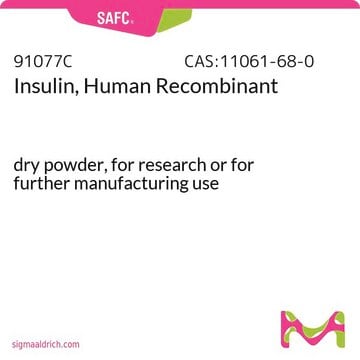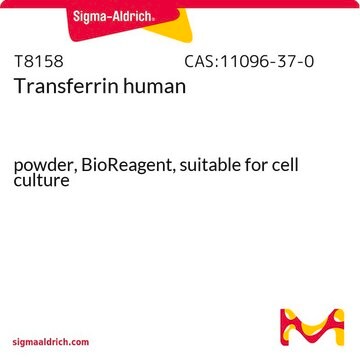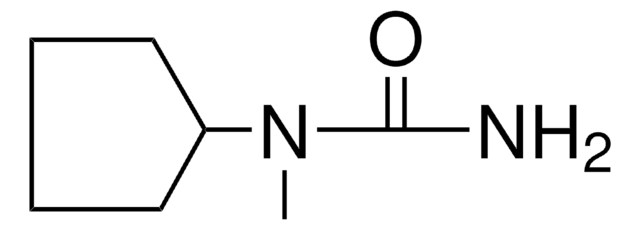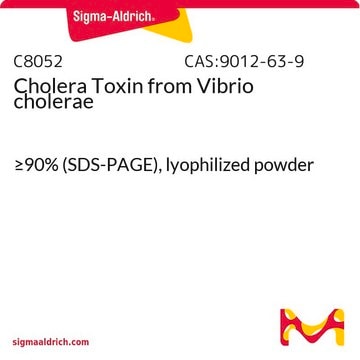This product is prepared from recombinant human insulin produced in Saccharomyces cerevisiae.
I9278
Insuline solution human
sterile-filtered, BioXtra, suitable for cell culture
Sélectionner une taille de conditionnement
Sélectionner une taille de conditionnement
About This Item
Produits recommandés
Stérilité
sterile-filtered
Niveau de qualité
Gamme de produits
BioXtra
Forme
solution
Concentration
9.5-11.5 mg/mL
Technique(s)
cell culture | mammalian: suitable
Impuretés
≤50 EU/mL endotoxin
pH
7.9-8.5
Numéro d'accès UniProt
Température de stockage
2-8°C
Clé InChI
PBGKTOXHQIOBKM-FHFVDXKLSA-N
Informations sur le gène
human ... INS(3630)
Description générale
Application
Cette insuline a été utilisée dans des tests de tolérance à l'insuline chez le rat et la souris.[1][2] Elle a également été utilisée pour la différenciation adipogène de cellules stromales mésenchymateuses humaines (CSMh) et de cultures d‘excroissances dérivées de cellules souches embryonnaires humaines (CSEh).[3][4]
Actions biochimiques/physiologiques
Autres remarques
Forme physique
Vous ne trouvez pas le bon produit ?
Essayez notre Outil de sélection de produits.
Produit(s) apparenté(s)
Code de la classe de stockage
12 - Non Combustible Liquids
Classe de danger pour l'eau (WGK)
WGK 2
Point d'éclair (°F)
Not applicable
Point d'éclair (°C)
Not applicable
Faites votre choix parmi les versions les plus récentes :
Certificats d'analyse (COA)
Vous ne trouvez pas la bonne version ?
Si vous avez besoin d'une version particulière, vous pouvez rechercher un certificat spécifique par le numéro de lot.
Déjà en possession de ce produit ?
Retrouvez la documentation relative aux produits que vous avez récemment achetés dans la Bibliothèque de documents.
Les clients ont également consulté
Protocoles
Discover our collection of primary human hepatic Kupffer cells and protocol for thawing, plating, and growing Kupffer cells. Find the formulation for Kupffer culture maintenance media.
Discover our primary human hepatocytes and plating and maintenance media formulations. Explore our protocol for plateable primary hepatocyte cell culture.
Discover our protocol for thawing, plating, and forming hepatocyte spheroids from human spheroid-qualified plateable hepatocytes. Find the formulation for hepatocyte spheroid maintenance media.
Contenu apparenté
Explore our protocol for suspension primary hepatocyte cell culture. Discover our primary human hepatocytes and plating and maintenance media formulations.
-
How is this insulin produced? In E.Coli? Yeast?...?
1 answer-
Helpful?
-
-
Is this product suitable for insulin tolerance tests in mice
1 answer-
This item has not been specifically tested for suitability in insulin tolerance. However, the product has been used successfully in a number of published papers. Please see the link below to review one such article:
https://pmc.ncbi.nlm.nih.gov/articles/PMC2785638/Helpful?
-
-
How long does the insulin remain potent for if stored in the fridge?
1 answer-
This product is assigned an expiration date of approximately 2 years from the date of Quality Release, when stored as directed at 2-8°C. The expiration date is lot specific and reported on the product label, as well as the Certificate of Analysis. Please see the link below to review a sample or lot specific Certificate:
https://www.sigmaaldrich.com/product/sigma/i9278#product-documentationHelpful?
-
-
Is this insulin considered of fast or slow action?
1 answer-
This product is intended for research use only and is not a Therapeutic insulin. The research grade insulin products are not defined by the Therapeutic types. There are analytical standards available for each type. Please see the links below to review additional product options for research use:
Insulin Glargine - Slow acting Insulin
https://www.sigmaaldrich.com/search/insulin-glargine?focus=products&page=1&perpage=30&sort=relevance&term=insulin%20glargine&type=productAspart Insulin - Fast acting Insulin
https://www.sigmaaldrich.com/search/insulin-aspart?focus=products&page=1&perpage=30&sort=relevance&term=insulin%20aspart&type=productLispro Insulin - Fast acting Insulin
https://www.sigmaaldrich.com/search/insulin-lispro?focus=products&page=1&perpage=30&sort=relevance&term=insulin%20lispro&type=productHelpful?
-
-
Is this human insulin suitable for use in mouse cell culture?
1 answer-
Yes, this product is suitable for mouse cell culture and has been cell culture tested on the L929 and 3T3 mouse cell lines. Please see the link below to review peer-reviewed articles that may be of interest:
https://www.ncbi.nlm.nih.gov/pmc/articles/PMC6892261/#:~:text=This%20process%20requires%20DRAM%2D1,and%20permitting%20efficient%20mTORC1%20activation.Helpful?
-
-
what is the morality of the product I9278, Insulin solution human?
1 answer-
The molarity of a 10 mg/mL solution of human insulin, with a molecular weight of 5807 daltons, is approximately 1.7 μmol/mL or 1.7 mM.
Helpful?
-
-
What kind of solution is the insulin (Product number: I9278) dissolved in?
1 answer-
The insulin (cat# I9278) is dissolved in HEPES solution.
Helpful?
-
-
Are there any contaminants (IgG, IgM example) in I9278?
1 answer-
Unfortunately, this product is not tested for impurities.
Helpful?
-
-
What is the content of the insulin solution/buffer (any perservatives and non insulin components?)
1 answer-
This product is prepared in a HEPES buffer, pH 7.9 - 8.5.
Helpful?
-
-
Can you store this product aliquoted at -20 degrees to extend shelf-life?
1 answer-
For research applications, freezing insulin solution has been a common pratice. However, solutions available on the commercial market for therapeutic use are never frozen, in order to maintain maximum activity. There have been no stability studies perform on the shelf life of frozen insulin solutions. Please see the link below to review a publication that may be helpful:
https://www.ncbi.nlm.nih.gov/pmc/articles/PMC8721649/Helpful?
-
Active Filters
Notre équipe de scientifiques dispose d'une expérience dans tous les secteurs de la recherche, notamment en sciences de la vie, science des matériaux, synthèse chimique, chromatographie, analyse et dans de nombreux autres domaines..
Contacter notre Service technique













